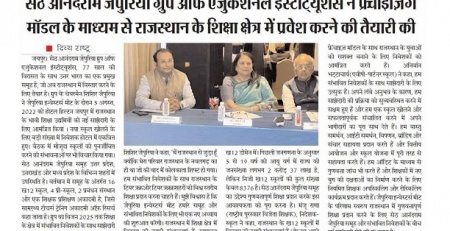Budget 2024: Urban-Rural schools funding discrepancies persist in education sector despite substantial investment
In the fiscal year 2024-25, the Indian government allocated an unprecedented Rs 73,498 crore to the Department of School Education and Literacy in the Interim Budget. This budget aims to enhance the educational landscape across the nation. Despite this substantial investment, significant discrepancies persist in the distribution of funds between urban and rural schools. These discrepancies contribute to a stark contrast in educational quality and accessibility.
The education budget in India is a composite of central and state funds. Experts believe that the urban schools generally receive a larger share of this budget due to several factors, including strategic locations and higher student densities. These schools benefit from superior infrastructure, a larger pool of qualified teachers and access to advanced teaching aids and technology.
“Conversely, rural schools often face severe financial constraints, resulting in a lack of basic amenities such as adequate classrooms, sanitation facilities and essential teaching materials. This disparity critically undermines the quality of education available to rural students, perpetuating a cycle of inequality,” Bikram Agarwal, Chief Financial Officer (CFO), Seth Anandram Jaipuria Group of Educational Institutions, said.
Factors contributing to funding disparities
According to the experts, urban areas typically have a higher density of students, which naturally attracts more government and private investments. The concentration of students in these regions makes it more cost-effective to invest in educational infrastructure and resources, leading to better-funded urban schools.
Furthermore, urban schools often benefit from stronger political connections and advocacy. “These connections enable them to secure a more significant portion of the education budget, further enhancing their resources and facilities. In contrast, rural schools lack similar political influence, resulting in lower funding and support,” he said.
Challenges in rural areas
Rural schools face numerous logistical challenges that impede efficient fund distribution and management. Geographic isolation, inadequate transportation and administrative inefficiencies contribute to the difficulties in delivering and utilising educational funds effectively in rural areas. These challenges exacerbate the existing disparities in educational quality.
Addressing the discrepancies
To bridge the gap between urban and rural education, several measures can be implemented. As per the experts, a more balanced allocation of funds is crucial. Policymakers should prioritise underfunded rural schools, ensuring they receive a fair share of the education budget. This can help create a more equitable educational environment across urban and rural areas.
There is a call for the government to lower the GST on educational products and services from 18% to 5%, aiming to make quality education more affordable and accessible, especially in rural areas. “Furthermore, promoting collaborations between urban and rural institutions and providing incentives for teachers to work in rural schools are essential measures to achieve educational equity,” Birender Singh, Group Chief Accounts Officer, GD Goenka Group, said.
Addressing these disparities requires a holistic approach, involving both increased funding and strategic policy implementation, to ensure that every student in India, regardless of their geographical location, has access to quality education and opportunities. “Policymakers and implementation agencies have the opportunity to innovate beyond traditional fundraising methods by exploring avenues such as crowdfunding and IT-enabled alumni networks to gather contributions for their alma mater,” he added.
Published by:- Financial Express
Published on:- 23 June 2024
Link:- https://www.financialexpress.com/budget/budget-2024-urban-rural-schools-funding-discrepancies-persist-in-education-sector-despite-substantial-investment-3532696/








